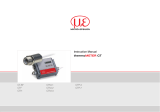
50
Cold Junction
Compensation Accuracy:
±0.5 / ±0.9
Temperature Coefficient: 0.01% of F.S. / ℃
Isolated Input Protection
between any two inputs:
350Vp-p
Dimension: 257(L) x 155(W) x 57(H) mm
10.1" (L) x 6.1" (W) x 2.2" (H)
Weight: 1160g / 40.9oz (Batteries included)
Operation Environment: 0 ~ 50, 85% RH
Storage Environment: -20 ~ 60, 75% RH
Accessories: User manual x 1
1.5V AA alkaline batteries x 8
USB cable x 1
Software CD x 1
Software manual x 1
SD card (2GB) x 1
K-type thermocouples (-50~200℃ /
-58 ~392℉): 1-meterx7pcs.;
3-meterx1pc.
Carrying bag x 1
Option:
Thermal Printer
SDHC card (8GB, Maximum)
Mini connector for analog Input
Optical RS-232 to USB bridge
3
■ 8 input temperature measurement/data logging (℃/℉)
■ Graphic display of overall trend for each input
■ 4.5” STN LCD (240 x 128) with backlight
■ Timers for the durations out of HI and LO limits
■ Selection of 11 types of thermocouple (K, J, E, T, R, S, N,…)
■ Easy socket for thermocouple mini connector
■ Basic accuracy 0.05% ± 1 ℃ (K type)
■ Programmable Hi-Lo alarm for each input.
■ Display of max and min values for each input
■ Sampling Rate 8 Inputs / 1 second
■ 24 Hour Recording with Alkaline Batteries of 2400mAH
■ Standard 2G SD memory card (stores 3.8-year data)
■ Optional 8G SDHC memory card
■ SD card directly read by PC
■ Easy data file management (Read and Delete functions)
■ Built-in calendar clock
■ Independent Input Setup (type of thermocouple, Hi-Lo alarm
values, name of Engineering Unit)
■ Isolated Input Protection of 350Vp-p between any two inputs
■ Programmable Engineering Unit (E.U.) to integrate Analog
Output (-60 to 60 mV) from instruments (e.g. Sound level meter,
Humidity meter, Current adaptor)
■ Screen hardcopy into files
■ Paperless Recorder
■ Ready to use package (Thermocouples, Memory Card, and
Batteries etc.)
I. Features




















